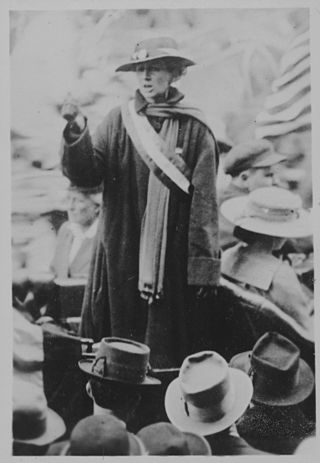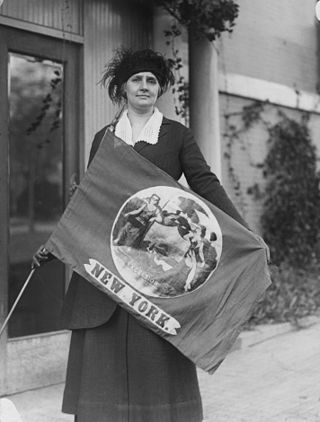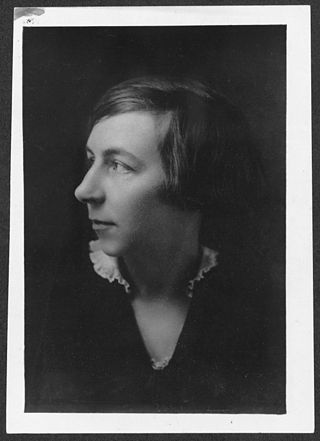Related Research Articles

Occoquan is a town in Prince William County, Virginia. The population was 934 at the 2010 United States Census. The current mayor is Earnest W. Porta Jr.

The Silent Sentinels, also known as the Sentinels of Liberty, were a group of over 2,000 women in favor of women's suffrage organized by Alice Paul and the National Woman's Party, who nonviolently protested in front of the White House during Woodrow Wilson's presidency starting on January 10, 1917. Nearly 500 were arrested, and 168 served jail time. They were the first group to picket the White House. Later, they also protested in Lafayette Square, not stopping until June 4, 1919 when the Nineteenth Amendment to the United States Constitution was passed both by the House of Representatives and the Senate.

The Lorton Reformatory, also known as the Lorton Correctional Complex, is a former prison complex in Lorton, Virginia, established in 1910 for the District of Columbia, United States.

The Workhouse Arts Center in Lorton, Virginia is a vibrant, 55-acre center for the arts and arts education that, through adaptive reuse, utilizes existing structures on repurposed land in the former Lorton Reformatory. A strong community partner with a growing national reputation, the Workhouse hosts celebrations, offers space for special events, and showcases Fairfax County's commitment to the arts. The Workhouse is a 501(c)3 non-profit organization and relies on the generosity of WAC partners and community.

The Occoquan River is a tributary of the Potomac River in Northern Virginia, where it serves as part of the boundary between Fairfax and Prince William counties. The river is a scenic area, and several local high schools and colleges use the river for the sport of rowing.

Women's suffrage was established in the United States on a full or partial basis by various towns, counties, states and territories during the latter decades of the 19th century and early part of the 20th century. As women received the right to vote in some places, they began running for public office and gaining positions as school board members, county clerks, state legislators, judges, and, in the case of Jeannette Rankin, as a member of Congress.

Dora Lewis, also known as Mrs. Lawrence Lewis, was an American suffragist. She was active in the National American Woman Suffrage Association and later helped found the National Woman's Party. Lewis took part in the Silent Sentinels protest to advocate for women's suffrage.

Florence Bayard Hilles (1865–1954) was an American suffragist, one of the founders of the National Woman's Party.

Mary A. Nolan was an American suffragist known for her narrative recounting the Night of Terror. She spent much of her life in Jacksonville, Florida, and was often described as one of the oldest suffragists active on the National Woman's Party (NWP) picket lines. Sent to prison five times, she was the only suffragette from Florida to go to prison as a result of their activism. Nolan also became one of the first women to vote in Florida. She was buried at Evergreen Cemetery in Jacksonville.

Matilda Hall Gardner (1871–1954) was an American suffragist and a member of the national executive committee of the National Woman's Party.

Edith M. Ainge (1873–1948) was an American suffragist and a Silent Sentinel. Ainge joined the National Woman's Party NWP led by Alice Paul, aiming to get the 19th amendment ratified. Ainge was arrested approximately five times from September 1917 to January 1919 for "unlawful assembly" at NWP protests, and she eventually went on to serve as treasurer of the NWP.

Katharine A. Morey was an American Suffragist, Silent Sentinel, officer of the Massachusetts State Branch of the National Woman's Party, and a member of the NWP Advisory Council. She and Lucy Burns were the first two American women to be arrested in front of the White House for the cause of women's suffrage.

The "Prison Special" was a train tour organized by suffragists who, as members of the Silent Sentinels and other demonstrations, had been jailed for picketing the White House in support of passage of the federal women's suffrage amendment. In February 1919, 26 members of the National Woman's Party boarded a chartered train they dubbed the "Democracy Limited" in Washington, D.C. They visited cities across the country where they spoke to large crowds about their experiences as political prisoners at Occoquan Workhouse, and were typically dressed in their prison uniforms. The tour, which concluded in March 1919, helped create support for the ratification effort that ended with the adoption of the Nineteenth Amendment on August 26, 1920.

Nina Samorodin was born in Kiev, Russian Empire to a Jewish family. Samorodin took advantage of increasing educational opportunities available to Jews in the city and graduated from Kiev University. After immigrating to the United States in 1914, she became involved in both union and women's activism. Samorodin was a factory worker and then general organizer of the Shirt Makers’ Union of Philadelphia. She was the executive secretary of the National Labor Alliance for Trade Relations with and Recognition of Russia. By 1922, she was also the secretary of the Women's Trade-Union League. Additionally, she taught at the Rand School of Social Science in New York City. However, Samorodin is most well known for her work with the National Woman's Party.

Julia Ridgely Emory was an American suffragist from Maryland, who led protests in Washington, D.C., for women's right to vote.

Catherine Mary Flanagan was an American suffragist affiliated with the Connecticut Woman Suffrage Association and later the National Woman's Party. She was among the Silent Sentinels arrested for protesting outside the White House in 1917.
The Women's Suffrage National Monument is a planned memorial sculpture that will honor suffragists who organized and demonstrated for the women's right to vote in the United States.
Maud Powell Jamison was an American suffragist. She joined the National Women's Party in 1916, and organized in support of women's suffrage, which led to multiple arrests and four prison sentences. Along with Alice Paul, the chair of the National Women's Party, Jamison and others picketed in front of the White House to pressure President Woodrow Wilson to support women's suffrage from 1917 to 1919.
References
- 1 2 "Suffragist Memorial Construction Makes Progress". www.connectionnewspapers.com. Retrieved 2021-05-19.
- 1 2 "Pandemic Levels Blow to Women's Memorial Funding". www.connectionnewspapers.com. Retrieved 2021-05-19.
- 1 2 "Women's Suffrage Memorial Breaks Ground In Northern Virginia". NPR.org. Retrieved 2021-05-19.
- 1 2 "A New Suffragist Memorial Is Open in Virginia | Washingtonian (DC)". Washingtonian. 2021-05-17. Retrieved 2021-07-21.
